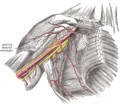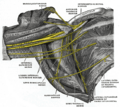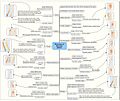Brachial plexus facts for kids
The brachial plexus is like a busy highway of nerves in your body. It's a network of nerves that starts in your spinal cord (which is inside your backbone) and goes all the way down to your arm, hand, and fingers. These nerves are super important because they carry messages between your brain and your arm, telling your muscles what to do and helping you feel things.
Contents
How the Brachial Plexus is Built
The brachial plexus is made up of several parts, like different sections of a road map. It has five main parts: roots, trunks, divisions, cords, and branches. Each part helps carry signals from your brain to your arm and back again.
The Roots: Where it Begins
The five roots are the very first part of the brachial plexus. They come directly out of your spinal cord in your neck area. Each root is named after the specific part of the spinal cord it comes from: C5, C6, C7, C8, and T1. Think of these as the starting points of the nerve highway.
The Trunks: Big Nerve Bundles
After leaving the spinal cord, these roots join together to form three bigger bundles called trunks:
- Upper trunk: Formed by the C5 and C6 roots.
- Middle trunk: Formed by the C7 root.
- Lower trunk: Formed by the C8 and T1 roots.
These trunks are like major roads that carry many nerve signals.
The Divisions: Splitting Up
Each of the three trunks then splits into two divisions. This means there are six divisions in total:
- Three anterior (front) divisions
- Three posterior (back) divisions
These divisions help sort the nerve signals, sending some to the front of your arm and others to the back.
The Cords: Coming Together Again
The six divisions then join up again to form three main cords. These cords are named based on where they are located in relation to a major blood vessel called the brachial artery:
- The posterior cord is made from all three posterior divisions. It carries signals for muscles on the back of your arm.
- The lateral cord is formed from the anterior divisions of the upper and middle trunks. It helps control muscles on the outer side of your arm.
- The medial cord is simply a continuation of the anterior division of the lower trunk. It controls muscles on the inner side of your arm.
Diagrams of the Brachial Plexus
Important Nerves from the Brachial Plexus
From these cords, several important nerves branch out. These nerves are like the final roads that go directly to your muscles and skin, allowing you to move your arm and hand, and to feel touch, temperature, and pain. Some of the main nerves include:
- Radial nerve: Helps you straighten your arm, wrist, and fingers.
- Axillary nerve: Helps you lift your arm away from your body.
- Musculocutaneous nerve: Helps you bend your elbow and feel things on your forearm.
- Median nerve: Controls many muscles in your forearm and hand, helping you grip things and feel your thumb, index, and middle fingers.
- Ulnar nerve: Controls some hand muscles and helps you feel your ring and pinky fingers.
Related pages
- Brachial artery
Images for kids
-
This shows a simulated example of a motorcyclist colliding with the floor at an angle, which may damage the brachial plexus nerves. The photo shows how the head and shoulder are extremely separated, which may stretch or even tear the nerves in the area between them. Protective gear can help prevent nerve damage by providing extra support on the opposite side of the head to prevent over-stretching the neck.
See also
 In Spanish: Plexo braquial para niños
In Spanish: Plexo braquial para niños








